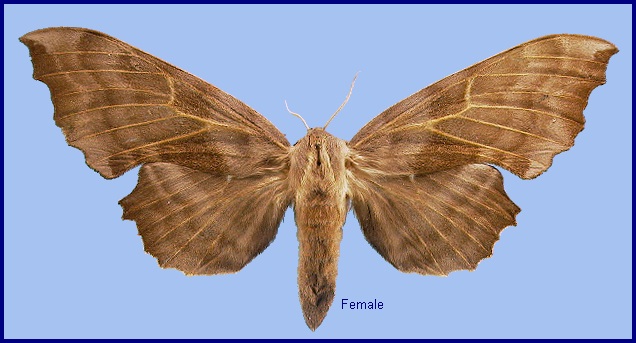
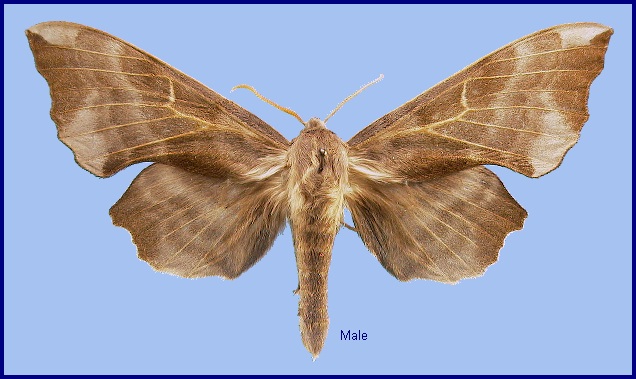
Smerinthus tremulae var. amurensis Staudinger, 1892, in Romanoff (ed.), Mém. Lépid. 6: 232. Type locality: [Russia, Khabarovskiy Krai/Primorskiy Krai,] Ussuri.
Homonym. Sphinx tremulae Boisduval, [1828], Eur. Lepid. Index meth.: 34. [This name is often incorrectly attributed to G. Fischer de Waldheim, 1830, Oryct. Gouv. Moscou (Ed 1): [25], pl. 10, figs 1, 2.]
Synonym. Smerinthus amurensis rosacea Staudinger, 1892.
Synonym. Laothoe tremulae baltica Viidalepp, 1979.
Note. This species is often referred to as Laothoe tremulae. However, as Sphinx tremulae Boisduval is a junior primary homonym of Sphinx tremulae Borkhausen, 1793 (see L. p. populi), the next oldest available name must be used.
Note. DNA barcodes of Laothoe amurensis amurensis differ from those of Laothoe amurensis sinica by 2.5-2.8% (Zolotuhin, 2018), which is not enough to consider them distinct species. Given that natural variation within clearly defined taxa of the Smerinthini can vary up to 3% or more, a variation of 3.5-4% is required before a population can be considered a new species. A difference of 3% or less indicates either a new subspecies or just natural variation within a given population.
Note. A new subspecies, namely Laothoe amurensis zolotuhini, has been proposed by Spitsyn, Bolotov & Spitsyna (2022) for the Japanese and Kurile Island (Kunashir Island) populations. Morphologically, it was said to differ from the nominotypical subspecies only in having a strongly toothed outer margin to the wings. However, examination of the long series of Japanese specimens in NHMUK suggests that this feature does not hold. That leaves only a DNA barcode divergence of 2.12-2.45% from the compared Eurasian mainland population as there are no differences in the male genitalia (and none was proposed in the original description). However, as no Japanese specimens were included in the analysis of Spitsyn et al. (2022) it is unclear what the relationship is between the population (ssp. zolotuhini) on Kunashir and the Japanese populations on Hokkaido and Honshu (and also those on Sakhalin Island, Russian Far East).
[Further details on this species in Japan, as well as photos of many stages, can be found on Digital Moths of Japan.]
Wingspan: 71-98mm. Closely resembles Laothoe amurensis sinica and, like that subspecies, generally lacking a rust-red patch at base of hindwing, although there may be a tint of brown or red present in some individuals.
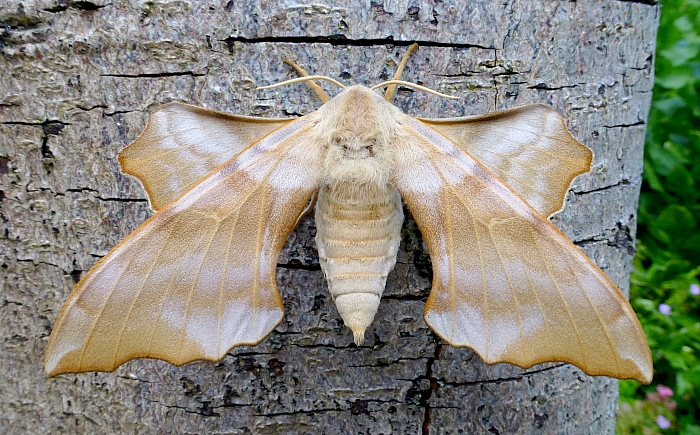
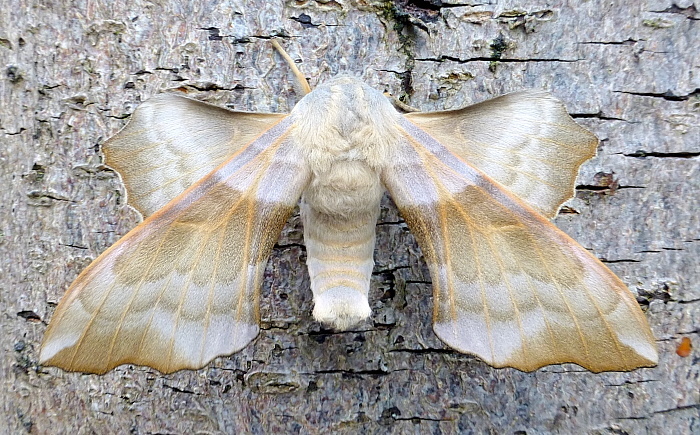
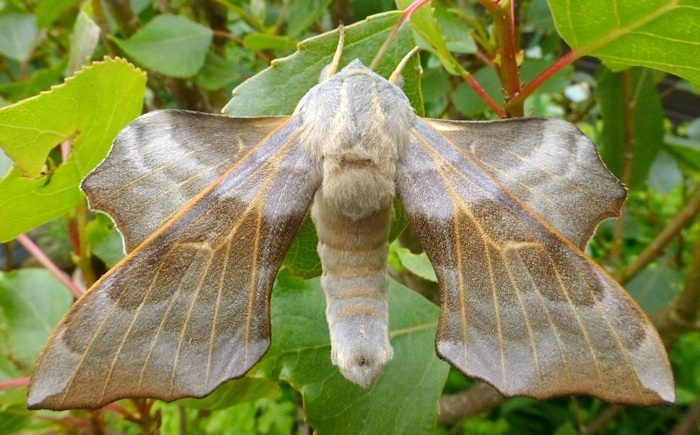
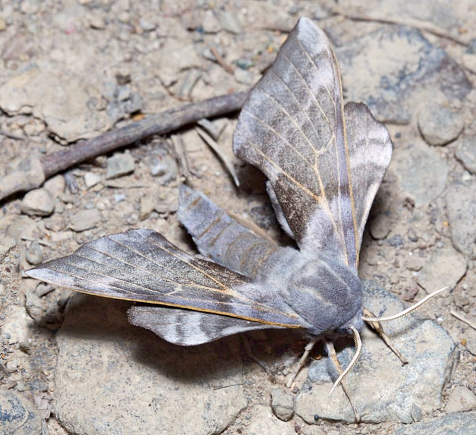
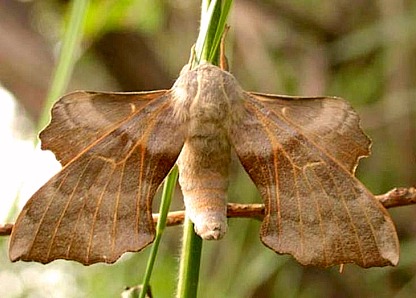
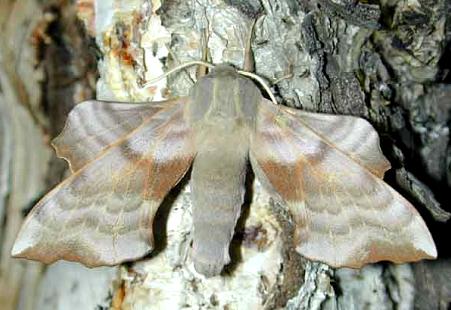
Confined to boreal mixed forests (cf. Laothoe amurensis sinica). In the Russian Far East, females are active from 22.20h until 01.10h, males from 23.10h until 03.40h (Izerskiy, 1999b)
China: 1-8.vii (Nei Mongol); 6-31.vii (Yichun); 30.vii (Liaoning). Japan: 19.vi (Honshu); 26.vi (Hokkaido); 3.vii-6.viii (Hokkaido). Russia: 1.vi-14.viii (Khabarovskiy Krai); vi (Primorskiy Krai); 20-25.vi (Tuva ASSR; Sakhalin Island); vi-viii (Siberia); 12.vii-4.viii (Khabarovskiy Krai); 16.vii (Transbaikalia); vii (Khabarovskiy Krai; Kurile Islands); vii-viii (Primorskiy Krai).
Univoltine; late June and July. Although this normally univoltine species usually flies in July, in some years individuals can be found as early as mid June and as late as mid August. The latter may, however, be part of a partial second brood (see below).
Yang (1978) claimed Laothoe amurensis amurensis is bivoltine in northern China, with adults flying in April/May and again in June/July. However, the locations given and the moth figured indicate that he was referring to Laothoe amurensis sinica.
If reared under warm conditions in captivity this species will produce a partial to full second brood, indicating that this may also happen under natural conditions (Roger Perkins, pers. comm. 2002).
OVUM: Glossy, greenish yellow, rather large for size of moth (2.3 x 2.0 x 1.9mm) and dorso-ventrally flattened. Each female deposits fewer than 100 eggs, singly, on the underside or petiole of a leaf, hatching 10--12 days later.
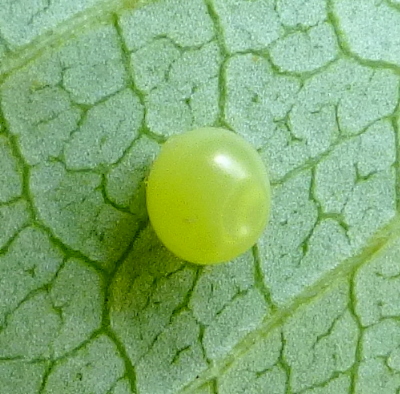
LARVA: Full-fed 65--80mm. Dimorphic: bluish green and dark green. The newly-emerged larva is pale green with faint yellow markings appearing after feeding. In the second instar, it assumes its final coloration and form, which is bluish green (sometimes dark green) with white oblique lateral stripes on abdominal segments 1--8 and covered in white tubercles. Resembles that of L. p. populi, except that the spiracles are larger and a pair of enlarged tubercles are present dorsally on thoracic segment 2; these tubercles become more noticeable as the larva grows (Pelzer, 1989). The spiracles are white, ringed with brown, and the short horn is bluish, dotted laterally with white. As in L. p. populi, it assumes a light plum colour prior to pupation.
On hatching, the larva commences feeding immediately on mature leaves. At first, these are skeletonized but, with increasing size, whole leaves are consumed except for the midrib (Skvortsov & Thomson, 1974). However, like the larva of L. p. populi, it is a wasteful feeder, with large segments of leaf being chewed off and falling to the ground. It feeds at night and, at first, rests by day stretched out under a leaf. In the second and later instars it assumes a sphinx-like attitude with its head hunched under the thorax; only the last 2--3 pairs of prolegs cling to the leaf. Fully-grown larvae tend to rest singly along a petiole, high up in mature trees where their colour enables them to blend superbly with the surrounding blue-green aspen leaves. When feeding on Populus, most individuals complete only four instars before pupation; some, however, pass through five instars, as do those feeding on Salix. This stage takes about 40--50 days, the resulting mature larva being larger than that of L. p. populi.
Occurs from late June to early August. In Siberia, larvae can sometimes be so abundant as to constitute a pest (Gninenko, 1998).
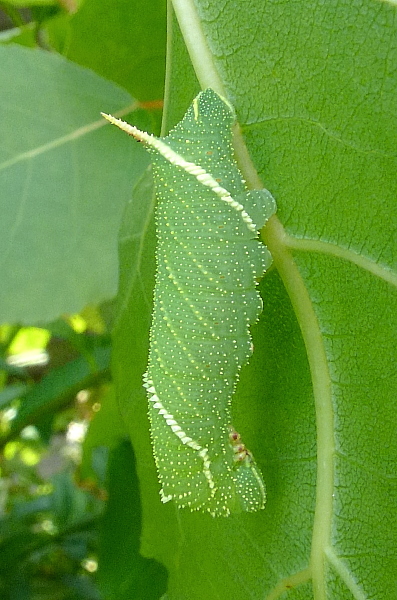
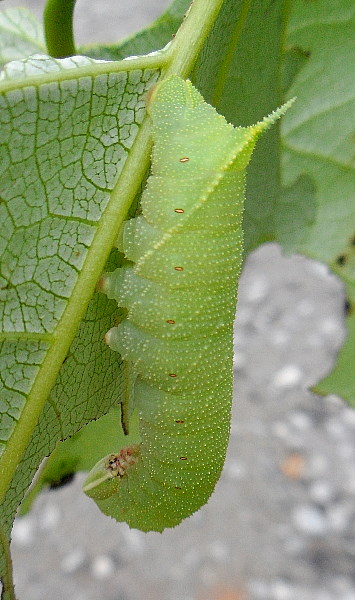
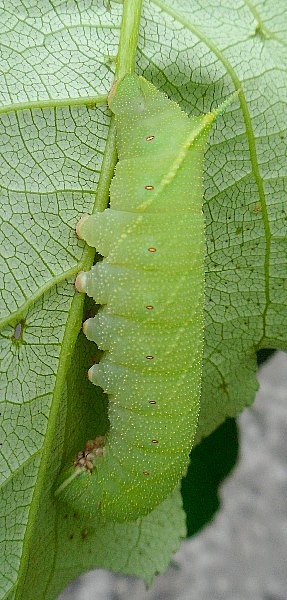
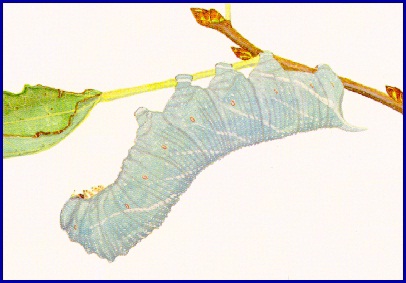
PUPA: 30--43mm. In colour and shape, almost identical to that of L. p. populi, except for the presence of a two-tier cremaster. Pupation normally takes place after only about four days in an unlined chamber, 2--3cm deep in the soil at the base of a tree or in a grass tussock. The overwintering stage.
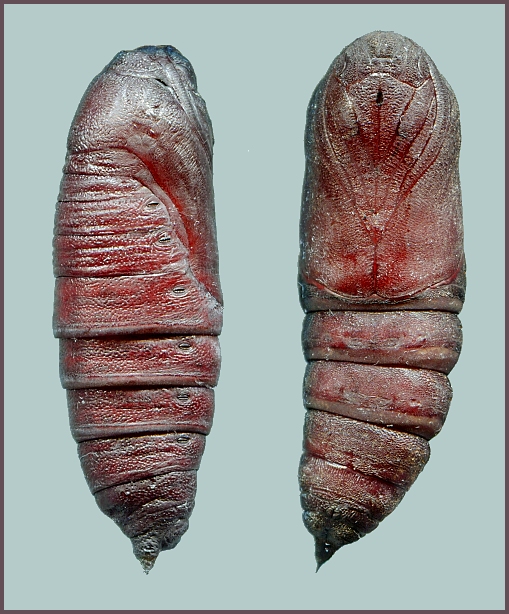
Larval hostplants. Recorded in 'Manchuria' on Populus (Oberthür, 1886). Chu & Wang (1980) listed Populus davidiana, P. maximowiczii and P. simonii under 'Amorpha amurensis'. However, the distributions of these trees in China, together with the localities given for the moth, suggest that these records are applicable to Laothoe amurensis sinica. Irrespective of this, records on Betula, Fraxinus and Tilia (Wang, 1978; Chu & Wang, 1980) are probably erroneous.
Unknown for the region.
China: Xinjiang (Altai); Nei Mongol (Chifeng/Ulanhad, Daguangdingzishan, 2061m; Ergun Youqi; Zalantun/Butha Qi; Zhenglan Qi/Xulun Hoh); Heilongjiang (Yichun; Lesser Khingan Mountains, Fengling Forest); Liaoning (Maquanzixiang, Fushun County).
Mongolia: Töv Province (Ulaan-Baatar City); Selenge Province (Tunkhel village, Khailaast; Baruun kharaa soum, Bayangol; Zuunburen Soum, Gangiin tokhoi).
Japan: Hokkaido (Oshima Province; Ishikari Province; Sapporo; Tesio; Kushiro; Tokachi; Rishiri Island; Mt. Daisetsu; Sounkyo; Shari); Honshu (Mt. Minoo, nr. Osaka; Kamasawa; Hirakawa).
Russia: Altai; Siberia (Bateki; Tomsk; Kireevsk; Pozdnyakovo; Kolomino; Bazoy; West Sayan Mts.; East Sayan Mts., 2600m; Novodubrovka; Novosibirsk; Chingisy; Suzun; Kalinovka; Alaevo; Kosa; Irkutsk); Tuva ASSR (Turan; Shurmak River); Yakutia/Sakha (Vitim; Olekminsk; Yakutsk); Buryatia (Shumilikha and Khakusa (Barguzin Nature Reserve); Muya; Engorboi; Ulentui; Mishikha (Baikalskii Nature Reserve); Deben; Mostovoi; Dzhirga; Kurumkan; Monakhovo; Yambui); Transbaikalia (Mt. Maly Bator; Nizhnii Tsasuchei; Butyvken; Bulum (Torei Lakes, Daurskii Nature Reserve); 20 km N Chita; Tupik; Amazar; Aksenovo-Zilovskoe; Shara; Kyra; Sokhondinskii Nature Reserve; Undino-Posel'e; Budymkan; Ur'upino); Amurskaya (Blagoveshchensk; Zeiskii Nature Reserve; Uril; Zeya; Tynda; Tygda; Magdagachi; Mukhino; Shimanovsk; Ekimchau, and many other places); Yevreyskaya (Bastak); Khabarovskiy Krai (Khabarovsk; Bolshekhekhtsyrskii Nature Reserve, Khabarovsk suburbs; Slavyanka; northern Bureinskii/Bureya Hills; Bureinskii/Bureya Nature Reserve; Lidoga; Innokent'evka; Komsomolsk-na-Amure; Pivan; Kiselevka; Arkhangelskoe; Nikolaevsk-na-Amure; Tugur; Nelkan; Botchinskii Nature Reserve; Tumninsky Nature Reserve); Primorskiy Krai (Vladivostok; Khasan; Suchan; Nahodka; Kedrovaya Pad Nature Reserve; Novovladimirovka; Ussuriysk; near Kalinovka; near Zanadvorovka; Livadia, near Anisimovka; Gribanovka, near Anisimovka); Sakhalin Island (Yuzhno-Sakhalinsk; Shebunino; Novoaleksandrovsk); Kurile Islands (Kunashir; Iturup).
Ranges from central Poland and southern Finland, east through Russia, southern Siberia, Yakutia/Sakha (Kaimuk et al., 2005) and Amurskaya (Streltzov, Osipov & Malikova, 2003) to the Pacific coast, including Sakhalin Island (Zolotarenko, Petrova & Shiryaev, 1978; Dubatolov, 1991; Dubatolov, 2023) and the southern Kurile Islands (Dubatolov, 1991). In the eastern Palaearctic, it occurs south as far as the Altai Mountains of Xinjiang (Zhang et al., 1986), northern Mongolia (Puntsagdulam et al., 2005; Enkhtur, Brehm, Boldgiv & Pfeiffer, 2021), northern Heilongjiang (2 specimens in IZAS), Primorskiy Krai (Russia) and Japan (Hokkaido, Honshu). Records from southern Heilongjiang (Hailin; Harbin; Lalin), Jilin, Liaoning, Hebei and Beijing are misidentifications of Laothoe amurensis sinica. Records from the Korean Peninsula appear to be all Laothoe amurensis sinica, as indicated by the specimens figured by Kim et al. (1982) and Park et al. (1999); however, this requires further study as a very small number of examples from the mountains of South Korea match Laothoe amurensis amurensis.
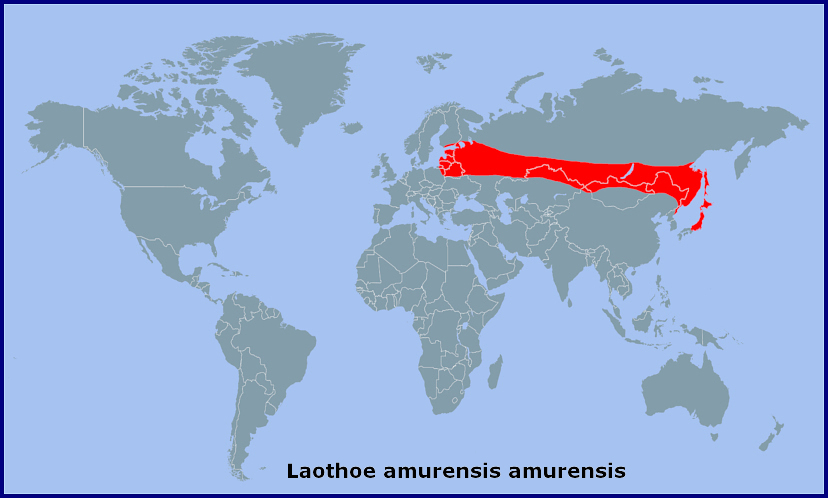
Holarctic; Palaearctic (both eastern and western). Pleistocene refuge: Monocentric -- Manchurian refuge.
 Return to Sphingidae of the Eastern Palaearctic species list
Return to Sphingidae of the Eastern Palaearctic species list